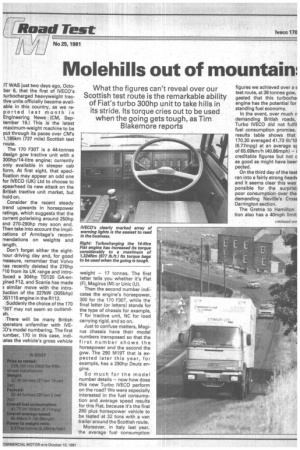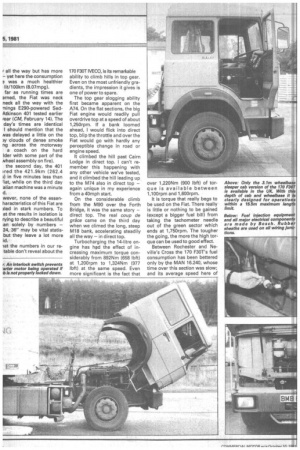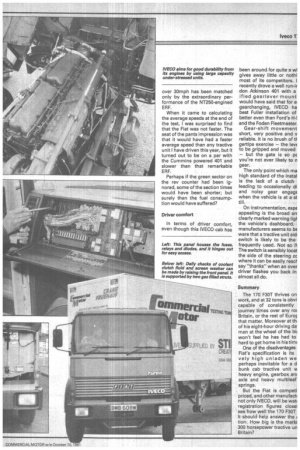Molehills out of mountain;
Page 37

Page 38

Page 39

If you've noticed an error in this article please click here to report it so we can fix it.
What the figures can't reveal over our Scottish test route is the remarkable ability of Fiat's turbo 300hp unit to take hills in its stride. Its torque cries out to be used when the going gets tough, as Tim Blakemore reports
IT WAS just two days ago, October 8, that the first of IVECO's turbocharged heavyweight tractive units officially became available in this country, as we reported last month in Engineering News (CM, September 19.) This is the latest maximum-weight machine to be put through its paces over CM's 1,185km (737 mile) Scottish test route.
The 170 F3OT is a 44-tonnes design gcw tractive unit with a 300hp/14-litre engine; currently only available in sleeper cab form. At first sight, that specification may appear an odd one for IVECO (UK) Ltd to choose to spearhead its new attack on the British tractive unit market, but hold on.
Consider the recent steady trend upwards in horsepower ratings, which suggests that the current polarising around 250hp and 270-290hp may soon end. Then take into account the implications of Armitage's recommendations on weights and length.
Don't forget either the eightnour driving day and, for good measure, remember that Volvo las recently deleted the 270hp F10 from its UK range and introluced a 304hp TD120 GA-en)ined F12, and Scania has made similar move with the introiuction of the 227kW (305bhp) 3S1115 engine in the R112.
Suddenly the choice of the 170 :30T may not seem so outland
sh.
There will be many British )perators unfamiliar with IVE:0's model numbering. The first lumber, 170 in this case, indigltes the vehicle's gross vehicle weight — 17 tonnes. The first letter tells you whether it's Fiat (F), Magirus (M) or Unic (U).
Then the second number indicates the engine's horsepower, 300 for the 170 F30T, while the final letter (or letters) stands for the type of chassis for example, T for tractive unit, NC for load carrying rigid, and so on.
Just to confuse matters, Magirus chassis have their model numbers transposed so that the first number shows the horsepower and the second the gvw. The 290 M19T that is expected later this year, for example, has a 290hp Deutz engine.
So much for the model number details — now how does this new Turbo IVECO perform on the road? We were especially interested in the fuel consumption and average speed results for this Fiat, because it's the first 290 plus horsepower vehicle to be tested at 32 tons with a van trailer around the Scottish route.
Moreover, in Italy last year, the average fuel consumption figures we achieved over a test route, at 38 tonnes gcw, gested that this turbochal engine has the potential for standing fuel economy.
In the event, over much n demanding British roads, Turbo IVECO did not fulfil fuel consumption promise. results table shows that 170.30 averaged 41.73 lit/10 (6.77mpg) at an average sr of 65.69km/h (40.86mph) — I creditable figures but not c as good as might have beer pected.
On the third day of the test ran into a fairly strong heady and it seems clear this was ponsible for the surprisii poor consumption over the demanding Neville's Crost Darrington section.
The Gretna to Hamilton tion also has a 40mph limit all the way but has more — yet here the consumption a was a much healthier lit/100km (8.07mpg).
far as running times are armed, the Fiat was neck neck all the way with the -nings E290-powered SedAtkinson 401 tested earlier rear (CM, February 14). The day's times are identical I should mention that the as delayed a little on the )y clouds of dense smoke rig across the motorway
a coach on the hard lder with some part of the ivheel assembly on fire).
the second day, the 401 :red the 421.9km (262.4 ;) in five minutes less than 'let, while on the third day alien machine was a minute d.
wever, none of the essenharacteristics of this Fiat are )led in stark numbers. To at the results in isolation is rying to describe a beautiful an solely by numbers — 24, 36" may be vital statisbut they leave a lot more id.
let the numbers in our re. table don't reveal about the 170 F3OT IVECO, is its remarkable ability to climb hills in top gear. Even on the most unfriendly gradients, the impression it gives is one of power to spare.
The top gear slogging ability first became apparent on the A74. On the flat sections, the big Fiat engine would readily pull overdrive top at a speed of about 1,250rpm. If a bank loomed ahead, I would flick into direct top, blip the throttle and over the Fiat would go with hardly any perceptible change in road or engine speed.
It climbed the hill past Cairn Lodge in direct top. I can't remember this happening with any other vehicle we've tested, and it climbed the hill leading up to the M74 also in direct top — again unique in my experience from a 40mph start.
On the considerable climb from the M90 over the Forth Bridge, it was the same story — direct top. The real coup de grace came on the third day when we climed the long, steep M18 bank, accelerating steadily all the way in direct top.
Turbocharging the 14-litre engine has hpd the effect of increasing maximum torque considerably from 892Nm (658 Ibft) at 1,200rpm to 1,324Nm (977 Ibft) at the same speed. Even more significant is the fact that over 1,220Nm (900 lbft) of torque is available between 1,100rpm and 1,600rpm.
It is torque that really begs to be used on the Fiat. There really is little or nothing to be gained (except a bigger fuel bill) from taking the tachometer needle out of the green sector which ends at 1,750rpm. The tougher the going, the more the high torque can be used to good effect.
Between Rochester and Neville's Cross the 170 F30T's fuel consumption has been bettered only by the MAN 16,240, whose time over this section was slow; and its average speed here of over 30mph has been matched only by the extraordinary performance of the NT250-engined ER F.
When it came to calculating the average speeds at the end of the test, I was surprised to find that the Fiat was not faster. The seat of the pants impression was that it would have had a faster average speed than any tractive unit I have driven this year, but it turned out to be on a par with the Cummins powered 401 and slower than that remarkable ER F.
Perhaps if the green sector on the rev counter had been ignored, some of the section times would have been shorter; but surely then the fuel consumption would have suffered?
Driver comfort In terms of driver comfort, even though this IVECO cab has been around for quite a wl gives away little or nothi most of its competitors. t recently drove a well run-ir don Atkinson 401 with a Hied gearlever mount would have said that for e. gearchanging, IVECO ha best Fuller installation of better even than Ford's Hand the Foden Fleetmaster.
Gear-shift movement short, very positive and v reliable. It is no brush of tt gertips exercise — the ley( to be gripped and moved — but the gate is so pc you're not ever likely to n gear.
The only point which ma high standard of the instal is the lack of a clutch leading to occasionally di and noisy gear engage when the vehicle is at a St till.
On instrumentation, espe appealing is the broad art clearly marked warning ligt the vehicle's dashboard. manufacturers seems to be ware that a tractive unit sid, switch is likely to be the frequently used. Not so 11 The switch is sensibly locat the side of the steering cc where it can be easily react say "thanks" when an over driver flashes you back in almost all do.
Summary
The 170 F3OT thrives on work, and at 32 tons is obvi capable of consistently journey times over any rot Britain, or the rest of Euror that matter. Moreover at th, of his eight-hour driving da man at the wheel of the LAI won't feel he has had to hard to get home in his tim(
One of the disadvantages Fiat's specification is its vely high unladen we perhaps inevitable for a d bunk cab tractive unit tA heavy engine, gearbox an axle and heavy multileaf springs.
But the Fiat is competi priced, and other manufacti not only IVECO, will be wati registration figures closel see how well the 170 F3OT It should help answer the ( tion: How big is the mark( 300 horsepower tractive un Britain?
























































